Back to the Project
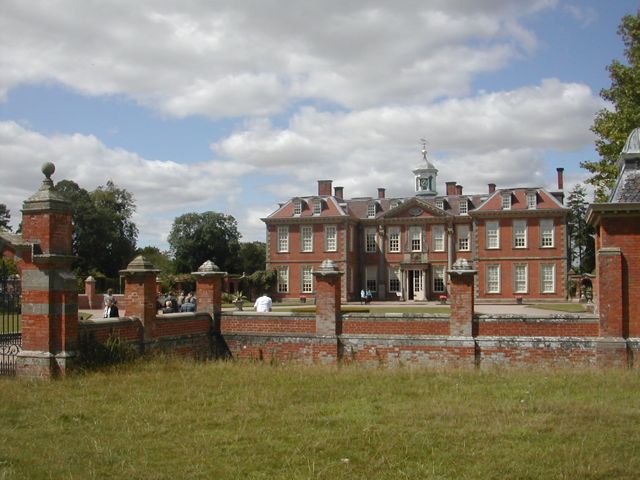
Hanbury Hall - the entrance front from the E
Writing
in the 1979 edition of 'Gardens of the National Trust', Graham
Stuart Thomas noted that a, 'bird's eye view is still extant, showing
its (a large formal garden) general layout and also a small amphitheatre to the north-west'.
Well this was enough to send me scurrying over there to take a look
courtesy of Neil Cook the head gardener who kindly provided me with
some very useful photocopied material as well as affording me the
opportunity to take a look round.
The first thing to clear up is some confusion in terminology - an amphitheatre in classical times was an oval shaped enclosure with a central arena often with opposed entrances and banked seating all the way round. As well as the great stone structures such as the amphitheatres at Nimes, Arles, Pompeii and of course the Colosseum itself - all made of stone - there were lesser examples on the fringes of the Roman Empire including Maumbury Rings (Dorset), Cirencester (Gloucestershire) and Silchester (Berkshire) to name but three. These survive largely as earthworks.
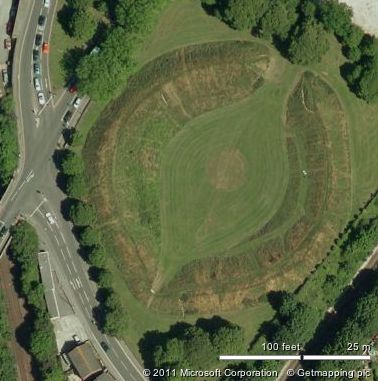
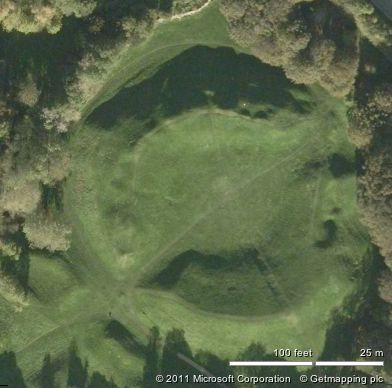
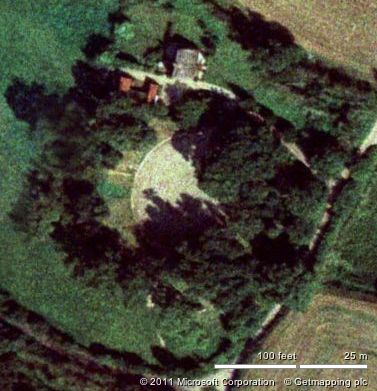
Roman Amphitheatres: Maumbury, Cirencester, Silchester
The kind of semi-circular form seen at Wilton and in the illustrated material from Hanbury share the same kind of layout as classical theatres where a stage area was the focus for a semi-circular bank of raised seating. Such structures as with the famous example at Epidauros, Greece were almost always cut into a convenient hill slope and, with the exception of Verulamium (St Albans) are absent from the British landscape. In general terms we may then perhaps define 'amphitheatre' in the context of seventeenth and eighteenth English garden architecture as a combination of earthworks: terraces, banks and/or ditches which define an area which is both curvilinear in outline and exhibits significant changes in level. So much for form, we'll leave the question of function until later when we will examine the question to what extent these constructions were consciously echoing classical models.
So back to Hanbury. The view Thomas had seen and an accompanying plan are reproduced (badly) below - the originals are in the Worcester County Record Office. What they clearly show is the outline of something which closely resembles a classical theatre: semi-circular in plan and marked with lines that could seem to represent seating arrangements. The truth is somewhat different. The site of the 'amphitheatre' (SP944641) is a low bluff facing north-west - the relief of the hill largely defines the shape of the site - as does a comparatively modern fence. Its function, made clear by what one assumes is a contemporary drawing, (see below) is that of a view point with lines of sight to prominent hills defined by avenues of planting. This is referred to on the plan and by the current staff as the 'Semi-circle'. Now structurally this bears very little resemblance to the Farnborough 'amphitheatre' but it does illustrate the pains to which people would go too to structure the viewing experience and it may well prove to be the case that our own example has some element of viewpoint in its rationale.
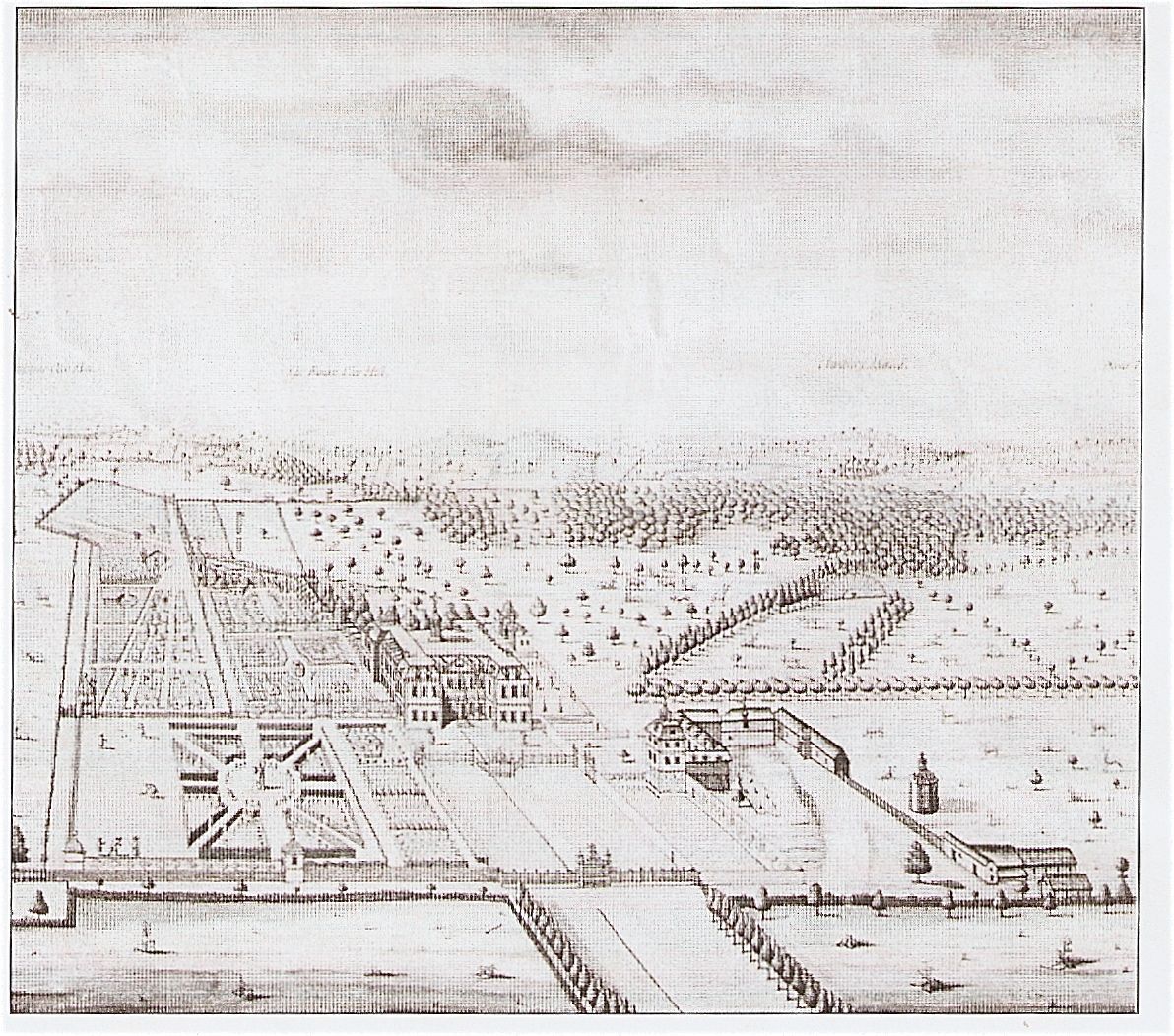

View and plan by Joseph Dougharty 1731 - 1733
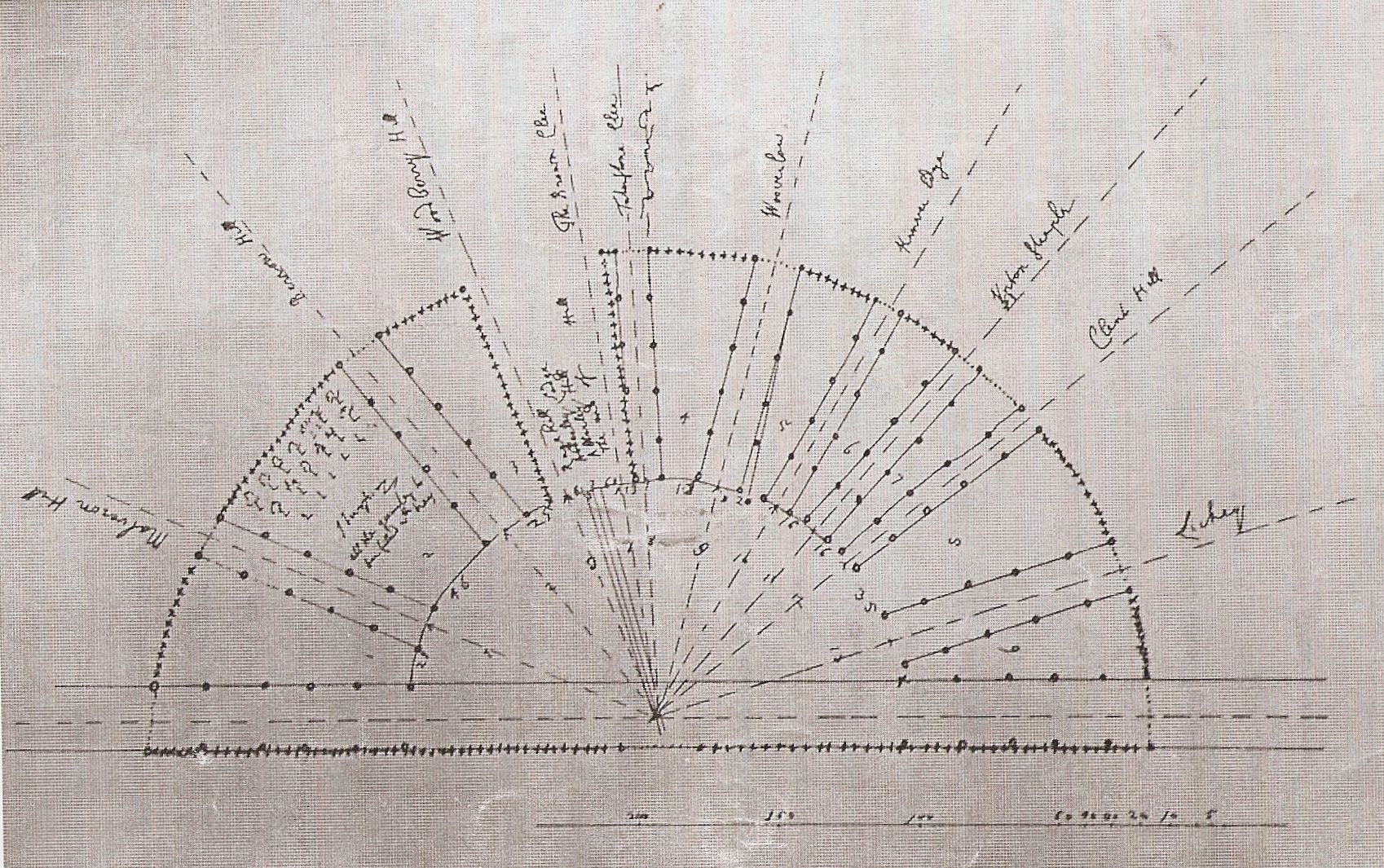
Plan of 'Semi-circle', I don't know the provenance of this, it's from a photocopy given me by Neil Cook, the head gardener at Hanbury. I must find out where he got it from.
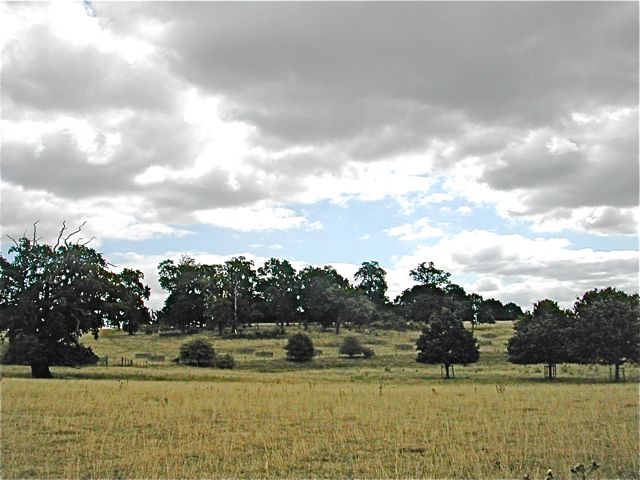
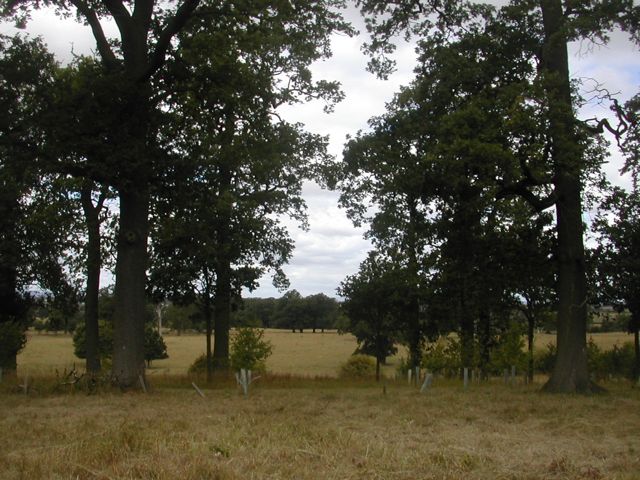
The 'amphitheatre' viewed from the west Looking out from the 'amphitheatre' towards the Clee Hills, now obscured by planting

Aerial view of the 'amphitheatre' and the adjacent 'Brick Kiln Pond'
Curiously enough there is another feature within the park which does bear an uncanny resemblance to a classical amphitheatre. Towards the north west corner of the park (SP 940642) is a rounded hollow with terraced sides reminiscent of seating and opposed entrances (See view and sections below). There are a series of broad deep ditches close by and the foundations of two large rectangular brick buildings to the north-west. Now the large pond below the Semi-circle is named ' Brick Kiln Pond' but I wondered if this was a mis-attribution. The complex described above looked like an abandoned clay pit with adjacent workshops and kiln. However, further information from Neil Cook indicated that they had had the complex down as marl pit next to the foundations of a set of kennels for the local hunt so there you are. This does suggest that it may be worth, therefore, searching for the remains of a brick kiln on the other side of the park.
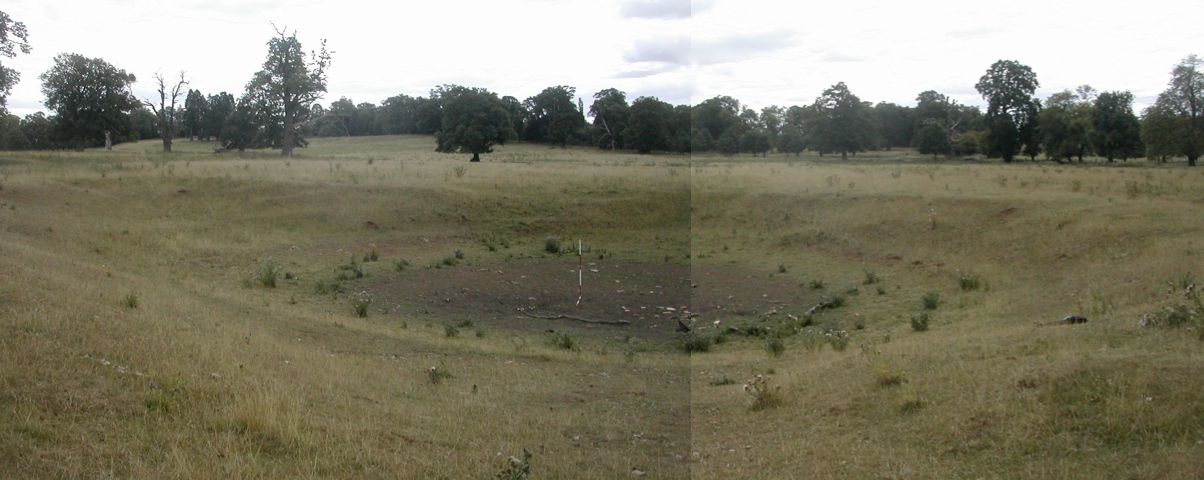
Panoramic view of marl pit looking south

Section across marl pit
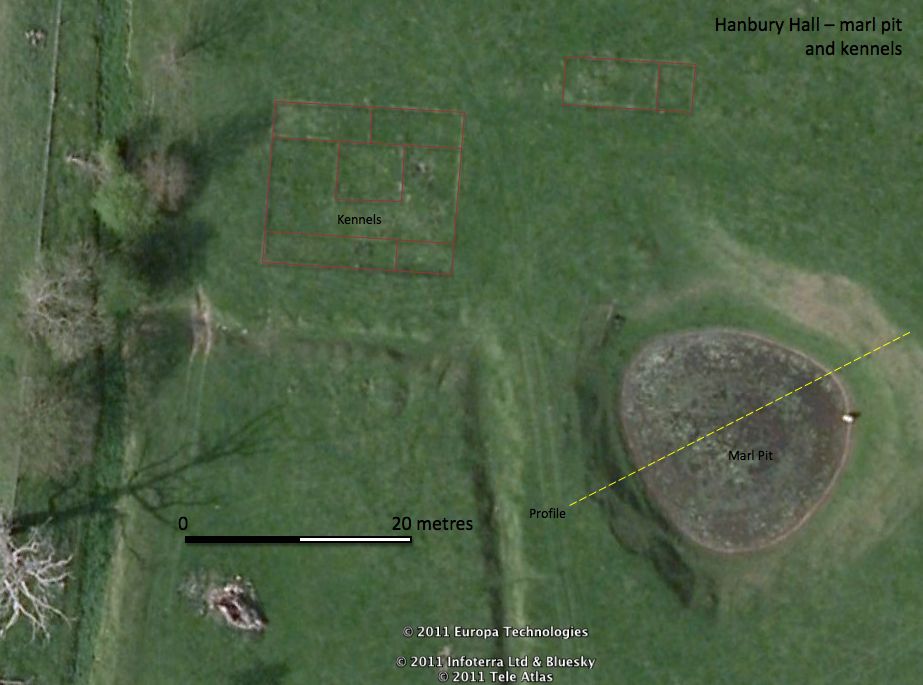
The first thing to clear up is some confusion in terminology - an amphitheatre in classical times was an oval shaped enclosure with a central arena often with opposed entrances and banked seating all the way round. As well as the great stone structures such as the amphitheatres at Nimes, Arles, Pompeii and of course the Colosseum itself - all made of stone - there were lesser examples on the fringes of the Roman Empire including Maumbury Rings (Dorset), Cirencester (Gloucestershire) and Silchester (Berkshire) to name but three. These survive largely as earthworks.



Roman Amphitheatres: Maumbury, Cirencester, Silchester
The kind of semi-circular form seen at Wilton and in the illustrated material from Hanbury share the same kind of layout as classical theatres where a stage area was the focus for a semi-circular bank of raised seating. Such structures as with the famous example at Epidauros, Greece were almost always cut into a convenient hill slope and, with the exception of Verulamium (St Albans) are absent from the British landscape. In general terms we may then perhaps define 'amphitheatre' in the context of seventeenth and eighteenth English garden architecture as a combination of earthworks: terraces, banks and/or ditches which define an area which is both curvilinear in outline and exhibits significant changes in level. So much for form, we'll leave the question of function until later when we will examine the question to what extent these constructions were consciously echoing classical models.
So back to Hanbury. The view Thomas had seen and an accompanying plan are reproduced (badly) below - the originals are in the Worcester County Record Office. What they clearly show is the outline of something which closely resembles a classical theatre: semi-circular in plan and marked with lines that could seem to represent seating arrangements. The truth is somewhat different. The site of the 'amphitheatre' (SP944641) is a low bluff facing north-west - the relief of the hill largely defines the shape of the site - as does a comparatively modern fence. Its function, made clear by what one assumes is a contemporary drawing, (see below) is that of a view point with lines of sight to prominent hills defined by avenues of planting. This is referred to on the plan and by the current staff as the 'Semi-circle'. Now structurally this bears very little resemblance to the Farnborough 'amphitheatre' but it does illustrate the pains to which people would go too to structure the viewing experience and it may well prove to be the case that our own example has some element of viewpoint in its rationale.


View and plan by Joseph Dougharty 1731 - 1733

Plan of 'Semi-circle', I don't know the provenance of this, it's from a photocopy given me by Neil Cook, the head gardener at Hanbury. I must find out where he got it from.


The 'amphitheatre' viewed from the west Looking out from the 'amphitheatre' towards the Clee Hills, now obscured by planting

Aerial view of the 'amphitheatre' and the adjacent 'Brick Kiln Pond'
Curiously enough there is another feature within the park which does bear an uncanny resemblance to a classical amphitheatre. Towards the north west corner of the park (SP 940642) is a rounded hollow with terraced sides reminiscent of seating and opposed entrances (See view and sections below). There are a series of broad deep ditches close by and the foundations of two large rectangular brick buildings to the north-west. Now the large pond below the Semi-circle is named ' Brick Kiln Pond' but I wondered if this was a mis-attribution. The complex described above looked like an abandoned clay pit with adjacent workshops and kiln. However, further information from Neil Cook indicated that they had had the complex down as marl pit next to the foundations of a set of kennels for the local hunt so there you are. This does suggest that it may be worth, therefore, searching for the remains of a brick kiln on the other side of the park.

Panoramic view of marl pit looking south

Section across marl pit

Aerial view of marl pit and kennels